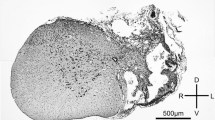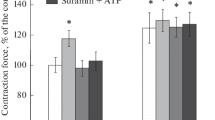Abstract
The aim of this study was to investigate the effect of axotomy and crush-related degeneration on the electrical activities of diaphragm muscle strips of experimental rats. In the present study, twenty-one male Wistar-albino rats were used and divided into three groups. The animals in the first group were not crushed or axotomized and served as controls. Phrenic nerves of the rats in the second and third groups were crushed or axotomized in the diaphragm muscle. Resting membrane potential (RMP) was decreased significantly in both crush and axotomy of diaphragm muscle strips of experimental rats (p < 0.05). Depolarization time (T DEP) and half-repolarization (1/2 RT) time were significantly prolonged in crush and axotomy rats (p < 0.05). Crushing or axotomizing the phrenic nerves may produce electrical activities in the diaphragm muscle of the rat by depolarization time and half-repolarization time prolonged in crush and axotomy rats.


Similar content being viewed by others
References
Kobayashi, J., Mackinnon, S. E., Watanabe, O., Ball, D. J., Gu, X. M., Hunter, D. A., & Kuzon, W. M, Jr. (1997). The effect of duration of muscle denervation on functional recovery in the rat model. Muscle and Nerve, 20(7), 858–866.
Lee, M., Doolabh, V. B., Mackinnon, S. E., & Jost, S. (2000). FK506 promotes functional recovery in crushed rat sciatic nerve. Muscle and Nerve, 23(4), 633–640.
Rotshenker, S. (2011). Wallerian degeneration: the innate-immune response to traumatic nerve injury. J Neuroinflammation, 8, 109.
Wu, S. C., Rau, C. S., Lu, T. H., Wu, C. J., Wu, Y. C., Tzeng, S. L., et al. (2013). Knockout of TLR4 and TLR2 impair the nerve regeneration by delayed demyelination but not remyelination. Journal of Biomedical Science, 20, 62.
Mueller, M., Leonhard, C., Wacker, K., Ringelstein, E. B., Okabe, M., Hickey, W. F., & Kiefer, R. (2003). Macrophage response to peripheral nerve injury: the quantitative contribution of resident and hematogenous macrophages. Laboratory Investigation, 83, 175–185.
Lee, H., Choi, S. Y., Seog Bae, O. H., Park, L., Kim, S. J., & Lee, S. J. (2006). Damaged neuronal cells induce inflammatory gene expression in schwann cells: implication in the Wallerian degeneration international. Journal of Oral Biology, 31(3), 87–92.
Lane, M. A., Fuller, D. D., White, T. E., & Reier, P. J. (2008). Respiratory neuroplasticity and cervical spinal cord injury: translational perspectives. Trends in Neurosciences, 31(2008), 538–547.
Shanmuganathan, K., Gullapalli, R. P., Zhuo, J., & Mirvis, S. E. (2008). Diffusion tensor MR imaging in cervical spine trauma. American Journal of Neuroradiology, 29, 655–659.
Nicaise, T. J., Hala, D. M., Frank, J. L., Parker, M. A., Leroy, K., Jean-Pierre, B., et al. (2012). Lepore Phrenic motor neuron degeneration compromises phrenic axonal circuitry and diaphragm activity in a unilateral cervical contusion model of spinal cord injury. Experimental Neurology, 235(2), 539–552.
Burns, J., & Dunning, J. (2010). Is the preservation of the phrenic nerve important after pneumonectomy? Interactive CardioVascular and Thoracic Surgery, 38(6), 798–800.
Watanabe, T., Trusler, G. A., Williams, W. G., Edmonds, J. F., Coles, J. G., & Hosokawa, Y. (1987). Phrenic nerve paralysis after paediatric cardiac surgery. Retrospective study of 125 cases. Journal of Thoracic and Cardiovascular Surgery, 94, 383–388.
Diehl, J. L., Lofaso, F., Deleuze, P., Similowski, T., Lemaire, F., & Brochard, L. (1994). Clinically relevant diaphragmatic dysfunction after cardiac operations. Journal of Thoracic and Cardiovascular Surgery, 107, 487–497.
Curtis, J. J., Nawarawong, W., & Walls, J. T. (1989). Elevated hemidiaphragm after cardiac operations: Incidence, prognosis, and relationship to the use of topical ice slush. Annals of Thoracic Surgery, 48, 764–768.
Aşkar, Z., Yurday, Ç.H. (1994). Heart and Vascular Surgery, İstanbul.
Yemişc, O.Ü. (2005). After cardiac surgery in infants and young children, show the frequency of transient phrenic nerve palsy and temporal course with electrodiagnostic methods. Master thesis, Institute of Health Sciences, Baskent University, Ankara.
Sayir, F., Kavak, S., Meral, I., Demir, H., Cengiz, N., & Çobanoğlu, U. (2012). Effect of crush and axotomy of phrenıc nerves on oxıdatıve stress ın dıaphragm muscle of rats. Muscle and Nerve, 45(3), 412–415.
Shındoh, C., Hıda, W., Kurosawa, H., Ebıhara, S., Kıkuchı, Y., & Takıshımaa, T. (1994). Effects of unilateral phrenic nerve denervation on diaphragm contractility in rat. Tohoku Journal of Experimental Medicine, 173, 291–302.
Nikolsky, E. E., Oranska, T. I., & Vyskocil, F. (1996). Non-quantal acetylcholine release in the mouse diaphragm after phrenic nerve crush and during recovery. Experimental Physiology, 81, 341–348.
Gıllıatt, R. W., & Hjorth, R. J. (1972). Nerve conduction during Wallerian degeneration in the baboon. Journal of Neurology, Neurosurgery and Psychiatry, 35, 335–341.
Martin-Caraballo, M., & Greer, J. J. (1999). Electrophysiological properties of rat phrenic motoneurons during perinatal development. Journal of Neurophysiology, 81(3), 1365–1378.
Sejersted, O. M., & Sjogaard, G. (2000). Dynamics and consequences of potassium shifts in skeletal muscle and heart during exercise. Physiological Reviews, 80, 1411–1481.
Meyer, F. J., Zugck, C., Haass, M., Otterspoor, L., Strasser, R. H., & Kubler, W. (2000). Inefficient ventilation and reduced respiratory muscle capacity in congestive heart failure. Basic Research in Cardiology, 95, 333–342.
Greer, J. J., Allan, D. W., Martin-Caraballo, M., & Lemke, R. P. (1999). An overview of phrenic nerve and diaphragm muscle development in perinatal rat. Journal of Applied Physiology, 86(3), 779–860.
Guyton, A. C. (2005). Resting membrane potential. In J. E. Hall (Ed.), Textbook of medical physiology (11th ed.). Missouri: Saunders.
Akaike, N. (1981). Sodium pump in skeletal muscle: Central nervous system-induced suppression by a-adrenoreceptors. Science, 213, 1252–1254.
Davis-Lopez de Carrizosa, M. A., Morado-Diaz, C. J., Tena, J. J., Benitez- Temino, B., Pecero, M. L., Morcuende, S. R., et al. (2009). Complementary actions of BDNF and neurotrophin-3 on the firing patterns and synaptic composition of motoneurons. Journal of Neuroscience, 29, 575–587.
Rasmussen, H. (1986). The calcium messenger system. New England Journal of Medicine, 314(17), 1094–1101.
Ogura, H., Tachibana, T., Yamanaka, H., Kobayashi, K., Obata, K., Dai, Y., et al. (2007). Axotomy increases plasma membrane Ca2+ pump isoform 4 in primary afferent neurons. NeuroReport, 18, 17–22.
Lunteren, E., & Moyer, M. (2003). Streptozotocin-diabetes alters action potentials in rat diaphragm. Respiratory Physiology & Neurobiology, 135, 9–16.
Kallen, R. G., Sheng, Z. H., Yang, J., Chen, L., Rogart, R. B., & Barchi, R. L. (1990). Primary structure and expression of a sodium channel characteristic of denervated and immature rat skeletal muscle. Neuron, 4, 233–242.
Acknowledgments
This work was supported by the Yüzüncü Yıl University Research Projects Department. We thank Dr. Nurettin Cengiz and Hava Bektaş.
Author information
Authors and Affiliations
Corresponding author
Rights and permissions
About this article
Cite this article
Alkiş, M.E., Kavak, S., Sayır, F. et al. The Effects of Phrenic Nerve Degeneration by Axotomy and Crush on the Electrical Activities of Diaphragm Muscles of Rats. Cell Biochem Biophys 74, 29–34 (2016). https://doi.org/10.1007/s12013-015-0708-3
Published:
Issue Date:
DOI: https://doi.org/10.1007/s12013-015-0708-3




